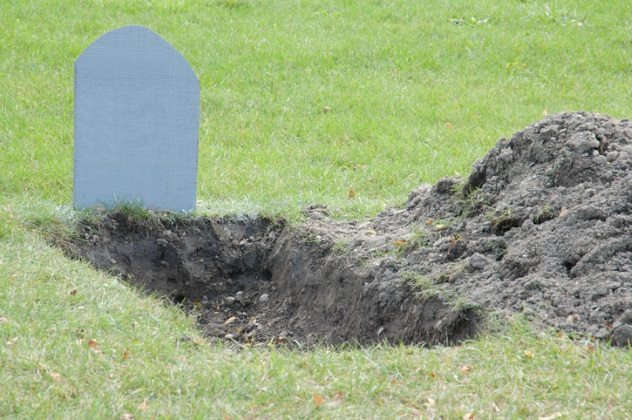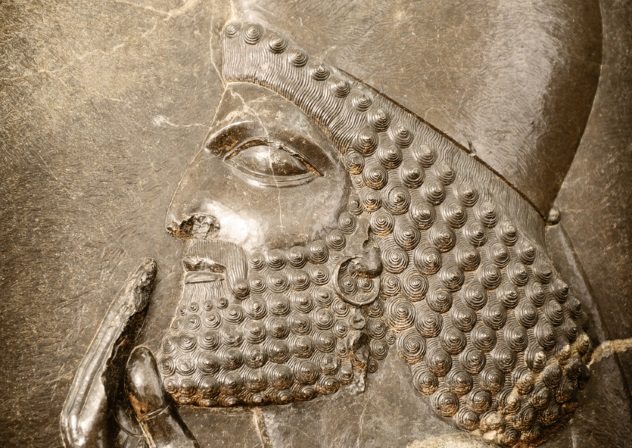 History
History  History
History  Animals
Animals Ten Times It Rained Animals (Yes, Animals)
 Mysteries
Mysteries 10 Devastating Missing Child Cases That Remain Unsolved
 Creepy
Creepy 10 Scary Tales from the Middle Ages That’ll Keep You up at Night
 Humans
Humans 10 One-of-a-kind People the World Said Goodbye to in July 2024
 Movies and TV
Movies and TV 10 Holiday Movies Released at Odd Times of the Year
 Politics
Politics 10 Countries Where Religion and Politics Are Inseparable
 Weird Stuff
Weird Stuff 10 Freaky Times When Famous Body Parts Were Stolen
 Miscellaneous
Miscellaneous 10 Interesting Things Manufacturers Stopped Making and Why
 Gaming
Gaming 10 Funny Tutorials in Games
 History
History 10 Desperate Last Stands That Ended in Victory
 Animals
Animals Ten Times It Rained Animals (Yes, Animals)
 Mysteries
Mysteries 10 Devastating Missing Child Cases That Remain Unsolved
Who's Behind Listverse?

Jamie Frater
Head Editor
Jamie founded Listverse due to an insatiable desire to share fascinating, obscure, and bizarre facts. He has been a guest speaker on numerous national radio and television stations and is a five time published author.
More About Us Creepy
Creepy 10 Scary Tales from the Middle Ages That’ll Keep You up at Night
 Humans
Humans 10 One-of-a-kind People the World Said Goodbye to in July 2024
 Movies and TV
Movies and TV 10 Holiday Movies Released at Odd Times of the Year
 Politics
Politics 10 Countries Where Religion and Politics Are Inseparable
 Weird Stuff
Weird Stuff 10 Freaky Times When Famous Body Parts Were Stolen
 Miscellaneous
Miscellaneous 10 Interesting Things Manufacturers Stopped Making and Why
 Gaming
Gaming 10 Funny Tutorials in Games
10 Stories Of The Future From Magic Mirrors And Crystal Balls
People have always had a fascination with predicting the future. From staring at tea leaves to examining animal entrails, self-proclaimed seers have found a myriad of ways to do so throughout history. One object sterotypically associated with attempting to see one’s future is the crystal ball.
Crystal gazing or “scrying” is what psychics do when they gaze into a crystal ball or reflective surface and claim to know your future. Mediums have been scrying for thousands of years, and their predictions obviously have mixed results. Sometimes, though, the prophecies are truly eerie.
10 The Ghost Mirror

Johann Georg Faust was a German alchemist who inspired the famous Faust legends. He wrote a book of spells, a “grimoire” called the Hollenzwang. According to the instructions in the book, if one wants to see the future in a mirror, they must go to the market on a Friday and buy the first mirror they find, no matter how expensive it is. If they haggle the price down, that means a demon can get inside.[1]
On the night of a new moon, the owner of the mirror must find a fresh grave, dig in the area where the face of the body would be, and bury the mirror facedown over the corpse. Nine weeks later, the seer had to dig up the mirror. Then, the names of three spirits must be said out loud in order to summon them. The names of the spirits change, depending on what sort of advice the seer was looking for.
The book also describes what successful visions are like. In these visions, the spirit of a beautiful man or woman will appear and guide the medium throughout the entire world, allowing them to see the answers to their questions about the past, present, and future.
9 The Visions Of ‘Miss X’

An anthropologist named Northcote W. Thomas wrote a few books during his life. Many of them were typical titles you would see from an anthropologist, like studies of tribes in Nigeria and the Aboriginal natives of Australia. However, he was particularly fascinated with psychic phenomenon, especially since stories of scrying pop up all over the world throughout history.
One of Thomas’s books was called Crystal Gazing and was published in 1905. In the introduction of the book, he says that the topic of whether or not someone believed in crystal gazing was a common question asked at parties. During a trip to London, a woman was hosting Thomas and a few of his friends. They all had a go at trying to see visions in a crystal ball but saw nothing. However, the woman, who he calls “Miss X,” described seeing a particular design. Soon after that, a book arrived in the mail that had just been published by one of Thomas’s other academic friends, and the front cover of the book had the same design from the vision.
Thomas decided to carry the crystal ball everywhere he went, asking people if they could see anything in it, just for fun. Another woman claimed that she saw Thomas in someone’s living room with a white Persian cat. She wrote out the scene in great detail, explaining the furniture, drapes, and the outfits the people were wearing. Later on, Thomas made some new friends and went into their house . . . to see a white Persian cat scamper by. The entire scene the woman had described did, in fact, come true. These two incidents were enough to turn Thomas into a believer, and he filled the book Crystal Gazing with similar stories.[2]
8 A Portal To The Underworld

In the 1200s, Friar Bacon was practicing the scientific method and experimenting with things that made people uneasy. He would look into a mirror and apparently talk to people who were far away. He would try to convince others that they could see their missing loved ones—if they just looked hard enough. Everyone was creeped out and kind of scared of him. In reality, he probably had a mental illness. However, with it being the 13th century and all, they naturally assumed he was working with the Devil. If a man died on the battlefield, they blamed it on Friar Bacon.[3]
Friar Bacon became a sort of a legend. There was even a play written by Robert Greene about him in the 1500s. In the story, he had serious magical powers and saw visions in the “glass prospective.” In this story, he became “The Emperor’s Magician.”
7 The Legend Of The Magical Tower

An Egyptian pharaoh stood in his tower. He had a magic mirror that allowed him to see his entire kingdom. If an enemy was approaching, he would see visions of these men in the mirror with enough time to gather the army and defend his country, even if they were more than 50 kilometers (30 mi) in the distance. The tower even had the power to shine the mirror’s lights upon the town, to let civilians know to evacuate. The mirror even had the ability to set enemy ships on fire.
This legend was translated into a few different languages and altered to suit different cultures as it spread throughout ancient history. People who read this story thought it sounded so magical that one translation even changed the mirror into a golden ball that gave the king visions of the future. They also added wizards and other magic powers to the story in order to make it more interesting and fantastic to the reader.
However, upon further inspection, this “legend” is true—and it wasn’t so magical, after all. It’s actually a true story about a lighthouse. In Alexandria, Pharaoh Ptolemy I Soter commissioned a massive lighthouse, which became known as the Seventh Wonder of the Ancient World. The mirrors did, in fact, have a view of over 50 kilometers. Modern experiments have shown that with the help of a piece of curved metal, the mirrors actually could have set the sails of enemy ships on fire once they reached the harbor, using the reflection of the Sun. At the time, lighthouses didn’t exist in other parts of the world, so the idea of its power was truly magical.[4]
6 Demons In Hand

During the Middle Ages, when paganism was being persecuted and Christianity was on the rise, some of the customs of predicting the future were still used, only adjusted to fit what was considered non-witchcraft. John of Salisbury became a bishop of the Catholic Church, and he wrote several manuscripts about his life and theology. He mentions in some of them that certain priests were in the habit of using young boys’ fingernails to do a Christian version of scrying, while others polished the bottom of a metal washbasin and stared into the reflection like a mirror. John wrote that he was one of the young boys who went through this ritual, yet he never saw any visions of the future.[5]
Another priest from the Middle Ages named Robert Reynys wrote a manuscript called Commonplace Book. He would use oil to shine the fingernails of young boys ages seven to 13 and made them sit on his lap. They recited a prayer asking God to send three angels who would reveal the truth about anything in the past, present, or future. He claimed that his “experiment” with these young boys was successful at summoning visions of angels and demons in the reflections in the boys’ nails.
A physician named Johannes Hartlieb describes a similar scene, where fortune-tellers called zaubermaisters would grab young boys and girls, polish their hands, and whisper spells and prayers in their ears. Sometimes, they held a sword or a crystal ball up to their face, demanding that the child look for reflections of angels and demons. Depending on the color (red means the angel is angry, and black means very angry), the priest would then light sage and make offerings to the angels until the child claimed that the vision of the angel became white again. Priests believed that this would help them get the outcome of the future they were hoping for.
5 The Queen’s Magician

During the 16th Century, Dr. John Dee was a genius scholar who was known for his studies in a variety of subjects, including mathematics, alchemy, and astronomy. He was also known to dabble in “magic,” looking into his crystal ball to make predictions of the future. During the reign of Queen Mary I, Catholicism became the national religion of England. It became illegal to practice magic. Despite the new laws, Mary’s sister, Elizabeth, asked John Dee for her horoscope. He predicted that in three years’ time, Mary would die and Elizabeth would be crowned as queen. Elizabeth tried to tell her sister of her fate, but Mary was understandably furious and put John Dee in jail.[6]
Three years later, John’s prediction came true. Mary died, and Elizabeth was to become queen. One of the first things she did was set him free. He became her advisor and was given property, where he was allowed to conduct any experiments he wanted. She wrote a decree that anything John Dee did was “white magic” and that he had a gift from God. Eventually, Dee began to deep-dive into the occult. He even claimed that he could speak to angels and demons. His table, where he did his scrying, was decorated with symbols he claimed were letters given to him by the angels. Dr. Dee’s crystals and artifacts have been preserved and can be visited at the British Museum in London.
4 The Magi

Some of the earliest known historic accounts of scrying came from Persia. The seers who used the reflections from water to see the future were called the Magi, which is where the word “magic” came from. A Persian poet named Firdausi wrote a poem in the tenth century which said, “He took up the cup, and gazed. He saw the seven chimes reflected there, and every act the presage of high heaven. In that cup, the wizard king was wont to see futurity.”[7]
Many ancient Persian mirrors had paintings on the back, personalized by their owners, as did other cultures. The idea of mirrors as scrying devices apparently existed in multiple ancient cultures, as well. An Etruscan mirror painting shows a scene of a man making love to a woman, while another naked woman stands and watches, suggesting that a threesome is about to occur. Off to the other side of the painting, a different woman is fully clothed, staring into a smaller handheld mirror, looking very sad. There is no written explanation to go with the painting, except the names of the lovers: Mexio and Fasia. It’s possible that the clothed woman may have “seen” her husband’s infidelity in the mirror.
3 The High Count

An Italian man who went by the name “Count Alessandro di Cagliostro” was an alchemist, magician, and Freemason who claimed he was capable of seeing the future through a crystal ball. He would entertain the nobility in the royal Italian court during the late 1700s. He predicted several things that apparently came true, including telling a young woman that she was going to die soon. Di Cagliostro was appointed by a prince, who he informed would come into some grave misfortune. He was also able to reveal scandalous secrets that people were trying to keep hidden from society.
Di Cagliostro claimed that his powers came from his “Egyptian Rite.” He also used DMT in order to have very vivid visions, which he would interpret as being part of a higher spiritual power. It turns out that his real name was Giuseppe Balsamo. He was eventually put in prison for heresy.[8]
2 The Lady Speaks

William Lilly was an astrologer and a political leader during the 1600s. In his autobiography, he wrote about scrying. Specifically, he included the story of a woman named Sarah Skelhorn. The first time Sarah predicted the future, she was staying with a family friend named Mrs. Stockman on the Isle of Purbeck. Mrs. Stockman wanted to go on a trip to London with Sarah’s mother, so they were wondering if she was on her way to the Isle of Purbeck to meet them. Since this was long before the age of telephones, Sarah consulted a crystal ball, and she told Mrs. Stockham that with the help of the “angels,” she saw a vision of her mother walking over to a trunk and taking out a red coat. Based on this vision, she assumed her mother was still at home.
The next day, Sarah went to her mother’s house to tell her about the trip to London. Her mother got up, walked to a trunk, and pulled out her brand-new red coat, which Sarah would have had no way of knowing about. Considering that Sarah was the daughter of Lord and Lady Beconsfield, her noble birth gave her more clout than typical fortune-tellers. Sarah went on to become what William Lilly called a “Speculatrix.” She looked into the crystal ball and made predictions of the future for doctors and some other renowned members of the community. While her premonitions were not anything life-changing, William Lilly was still fascinated enough by the story to write about it. Hundreds of years before social media, the idea of knowing what your family and friends were up to in a split second was incredibly fascinating, even if it was a mundane thing like a new red coat.[9]
1 The Prophecies

One of the most famous fortune-tellers in history was Michel de Nostradame, but most people know him as Nostradamus. In the 1500s, he worked as a doctor, treating victims of the plague in Italy and France. However, he is remembered for his prophecies, and people credit him with predicting multiple tragedies that occurred after his death.
His technique for scrying was placing a bowl of water on a brass tripod and staring into it until he saw visions of the future. Unlike many of the other stories on this list, Nostradamus had incredibly vivid visions, and he wrote short poems to describe each of these prophecies. Many people have read his poems and made them fit into some of the biggest events in history, like the 9/11 attacks and Hitler’s scars on humanity.[10]
In one story, Nostradamus was summoned by the queen of France, Catherine de’ Medici, because she wanted to know who the future kings of France would be. He handed her an enchanted mirror, and she was apparently able to see their faces.
Shannon Quinn is a writer and entrepreneur. You can find her on Twitter @ShannQ.
READ MORE BLURB GOES HERE Top 10 Predictions From Edgar Cayce and 10 Doomsday Predictions Beyond 2012.








